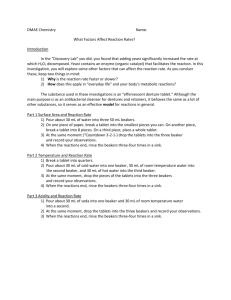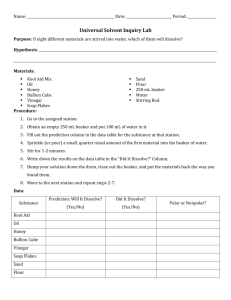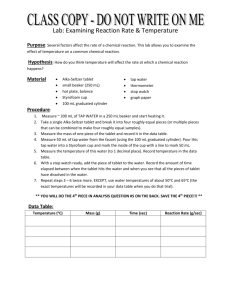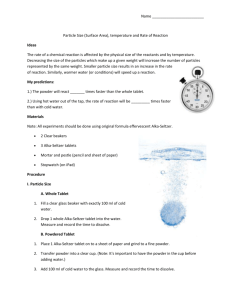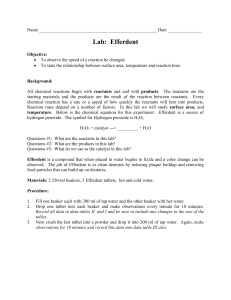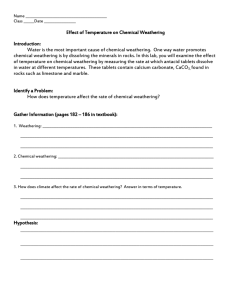Experiment 1: The Effects of Temperature on Rate of Reaction
advertisement
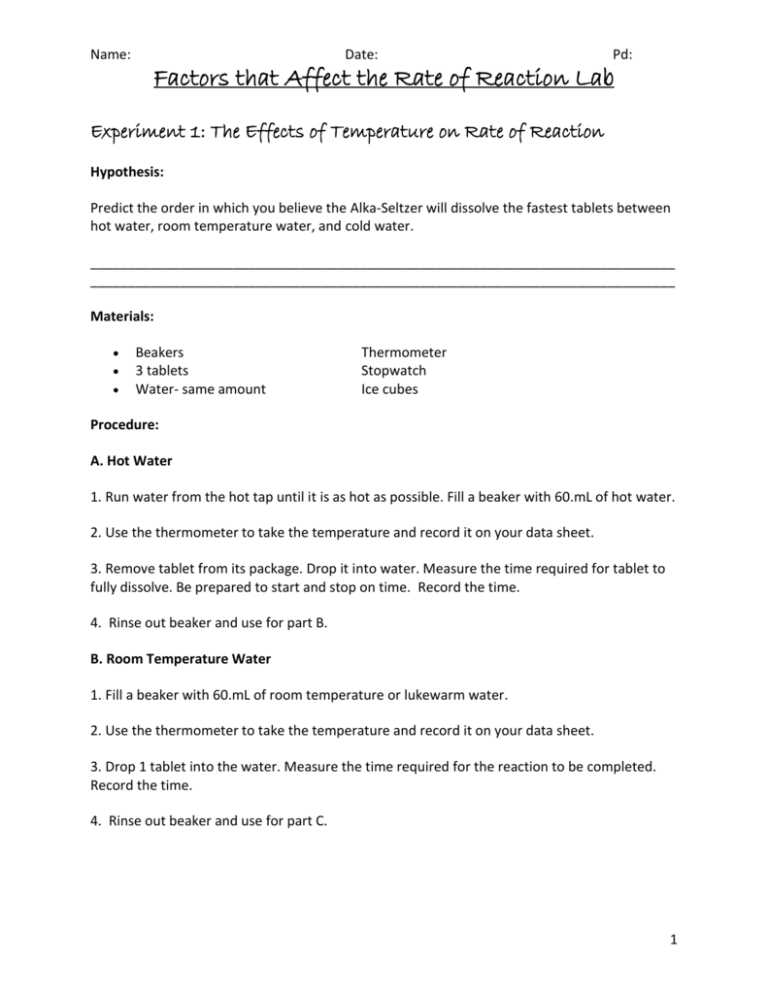
Name: Date: Pd: Factors that Affect the Rate of Reaction Lab Experiment 1: The Effects of Temperature on Rate of Reaction Hypothesis: Predict the order in which you believe the Alka-Seltzer will dissolve the fastest tablets between hot water, room temperature water, and cold water. ______________________________________________________________________________ ______________________________________________________________________________ Materials: Beakers 3 tablets Water- same amount Thermometer Stopwatch Ice cubes Procedure: A. Hot Water 1. Run water from the hot tap until it is as hot as possible. Fill a beaker with 60.mL of hot water. 2. Use the thermometer to take the temperature and record it on your data sheet. 3. Remove tablet from its package. Drop it into water. Measure the time required for tablet to fully dissolve. Be prepared to start and stop on time. Record the time. 4. Rinse out beaker and use for part B. B. Room Temperature Water 1. Fill a beaker with 60.mL of room temperature or lukewarm water. 2. Use the thermometer to take the temperature and record it on your data sheet. 3. Drop 1 tablet into the water. Measure the time required for the reaction to be completed. Record the time. 4. Rinse out beaker and use for part C. 1 Name: C. Cold Water Date: Pd: 1. Fill a beaker with 40mL. of water and add enough ice to adjust the level to 60mL. Stir the ice water for about 15 seconds so the temperature will come to equilibrium. 2. Use the thermometer to take the temperature and record it on your data sheet. (Leave the ice cubes in the water!) 3. Drop 1 tablet into the water. Measure the time required for the reaction to be completed. Record the time. 4. Rinse out beaker. Data/Observations: Type of Water Water Temperature (degrees C) Observations During Reaction Time for Reaction to be Completed (Seconds) Hot Tap Water Room Temperature Water Ice Water Analysis: Graph your data points on graph paper using water temperature (y-axis) vs. time to fully dissolve (x-axis) to show the effect of temperature on Rate of Reaction. Use your graph to help answer the questions below. Conclusion Summary: How does temperature affect the rate of reaction? ______________________________________________________________________________ ______________________________________________________________________________ Questions: 1. At a temperature of 10 degrees C, it would take _________ seconds for 1 tablet to react with 60 .mL of water. 2. If the temperature is doubled from 20 degrees C to 40 degrees C, the time for the rate of reaction __________by approximately ___________. 3. Using hot tap water, the rate was ___________ times faster than at 0 degrees C. 2 Name: Date: Pd: Factors that Affect the Rate of Reaction Lab Experiment 2: The Effect of Particle Size on Rate of Reaction Hypothesis: Predict the order in which you believe the tablets will dissolve the fastest between a whole tablet, a tablet broken into 4 pieces, a tablet broken into 8 pieces. ______________________________________________________________________________ ______________________________________________________________________________ Materials: Beaker 3 tablets Stopwatch Procedure: A. Whole Tablet 1. Fill a beaker with 60.mL of room temperature or lukewarm water. 2. Drop 1 whole tablet into the water. Measure and record the time to dissolve. 3. Rinse out beaker and use for part B. B. Tablet Broken into ~4 Pieces 1. Place 1 tablet onto a sheet of paper and break into approximately 4 pieces of about equal size. 2. Fill a beaker with exactly 60.mL of room temperature or lukewarm water. 3. Slide broken tablet into the water from the sheet. Measure and record the time to dissolve. 4. Rinse out beaker and use for part C. C. Tablet Broken into ~8 Pieces 11. Place 1 tablet onto a sheet of paper and break into approximately 4 pieces of about equal size. 2. Fill a beaker with exactly 60.mL of room temperature or lukewarm water. 3 Name: Date: Pd: 3. Slide broken tablet into the water from the sheet. Measure and record the time to dissolve. 4. Rinse out beaker and use for part C. Data/Observations: Particle Size Observations During Reaction Time for Reaction to be Completed (Seconds) Whole Tablet 4 Pieces 8 pieces Analysis: Graph your data on graph paper using particle size (y-axis) vs. time to fully dissolve (x-axis) to show the effect of particle size on Rate of Reaction. Use your graph to help answer the questions below. Conclusion Summary: a) As particle size decreases, the rate of reaction __________________. b) The rate of reaction for the smallest pieces was ___________ times faster than for the whole tablet. Questions: 1. As particle size decreases, the total surface area of a reactant ________________. As a result, the probability of interactions between atoms/ions ________________, and the rate of reaction ___________________. 2. Particle size appears to have _______________ (less or more) of an effect on the rate of reaction than temperature. 4 Name: Date: Pd: Factors that Affect the Rate of Reaction Lab Experiment 3: Effect of Concentration of the Reactants Hypothesis: Predict the order in which you believe the tablets will dissolve the fastest between 100% vinegar, 66.7% vinegar, and 33.3% vinegar. ______________________________________________________________________________ ______________________________________________________________________________ Materials: Beakers Vinegar 3 Tablets Water Stopwatch Procedure: 1. Make your 100% vinegar solution by measuring out 60mL of vinegar. 2. Make your 66.7% vinegar solution by measuring 40mL of vinegar and 20mL of water . 3. Make your 33.3% vinegar solution by measuring 20mL of vinegar and 40mL of water. 4. Drop the tablet in, record observations and time to dissolve. 5. Repeat step 4 for the remaining 2 concentrations. Data/Observations: Concentrations of Vinegar Observations During Reaction Time for Reaction to be Completed (Seconds) 100% Vinegar 60% Vinegar 20% Vinegar Analysis: 5 Name: Date: Pd: Graph your data on graph paper using concentration (y-axis) vs. time to fully dissolve (x-axis) to show the effect of concentration on Rate of Reaction. Use your graph to help answer the questions below. Conclusion Summary: How does concentration affect the rate of reaction? ______________________________________________________________________________ ______________________________________________________________________________ Questions: 1. Why does 100% vinegar react more quickly with the tablet? 6

